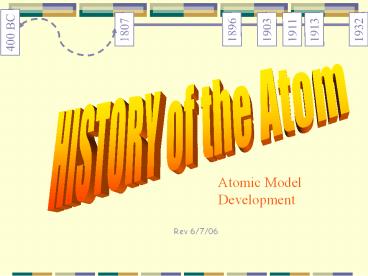NUCLEAR CHEMISTRY - PowerPoint PPT Presentation
Title:
NUCLEAR CHEMISTRY
Description:
1807 1896 1903 1911 1913 1932 Atomic Model Development Rev 6/7/06 Early Philosophers Democritus (460-370 BC) Defined an Atom as the smallest unit of a material that ... – PowerPoint PPT presentation
Number of Views:104
Avg rating:3.0/5.0
Title: NUCLEAR CHEMISTRY
1
HISTORY of the Atom
Atomic ModelDevelopment
Rev 6/7/06
2
Early Philosophers
3
Democritus (460-370 BC)
- Defined an Atom as the smallest unit of a
material that can not be split up - Greek word atom
- means invisible
4
Democrituss Theory
- Matter is made up of empty space through which
atoms move. - There is an indestructible and indivisible
particle called the atom. - Different atoms have different sizes and shapes.
- Different properties are related to the size and
shape of the atoms.
5
John Dalton (1766 1844)
- Revised Democrituss theory of the atom making
Daltons atomic theory. - Atom smallest particle of an element that still
retains the properties of that element.
6
Daltons Postulates - 1807
- All matter is made of atoms
- Atoms of same element are the same. If it is a
different element, the atoms are different
- Atoms can not be created or destroyed but can be
combined, rearranged, or separated.
- Atoms form in simple whole number
- ratios to form compounds.
- Example H2O water is always found in a 21
ratio
7
The History of Subatomic Particles
- William Crookes Invented cathode-ray tube
8
JJ Thomson (1856- 1940)
- Used cathode ray tube to perform experiments
using magnets and observing what effect the
magnets had on the ray within the tube
9
Thomsons Atom - 1897
- Discovered electrons are smaller than a Hydrogen
atom - Plum Pudding model of atom
10
(No Transcript)
11
Robert Millikan (1868 1909)
- Oil Drop Experiment
- Determined Charge of Electron (-1)
- Determined Mass of Electron 1/1840th that of
Hydrogen
12
The Nuclear Atom
- Rutherford (1871- 1937)
13
Rutherfords Gold Foil Experiment
- Performed and discovered by YOU!!!
- End Conclusions
- 1)
- 2)
14
James Chadwick
- Additional mass of nucleus must be made up by a
neutral particle known as - the neutron
15
Structure of an Atom
16
Nucleus
- responsible for most of the mass of the atom
- protons ( charge)
- neutrons (no charge)
17
Electrons
- (-) charge
- responsible for most
- of the volume of the
- atom
- negligible mass (0)
18
Determining P, N, and E
- Atomic Number The number of protons in an atom.
- In a neutral atom Number of protons number of
electrons - Mass Number
- protons neutrons
- of Neutrons
- atomic mass protons
19
Isotopes
- Kind of like twinsalike, but different
- Isotopes -Same element, but with different mass
due to different of neutrons - Same number of protons
20
Isotopes can be written 2 ways
21
1. Nuclear Notation
neutrons protons--gt
- mass --gt
- lt--element Symbol
- atomic --gt
39
K
19
protons--gt
22
2. Hyphen Notation
- Hyphen notation looks like this
- C-12 C-14
- The number after the hyphen mass number
(atomic mass) Carbon - So what does that mean?
23
Practice (Neutral Atoms)
Protons Electrons Neutrons
Silicon - 30
18O
He - 5
29 35
24
Average Atomic Mass
- Average Atomic Mass The average of all
naturally occurring isotopes.
25
- Uranium has three common isotopes. If the
abundance of 234U is 0.01, the abundance of 235U
is 0.71, and the abundance of 238U is 99.28,
what is the average atomic mass of uranium?
26
- Titanium has five common isotopes 46Ti (8.0),
47Ti (7.8), 48Ti (73.4), 49Ti (5.5), 50Ti
(5.3). What is the average atomic mass of
titanium?
27
Isotopic Abundance
- Nitrogen is made up of two isotopes, N-14
(14.00307) and N-15 (15.0001). Given nitrogen's
atomic weight of 14.007, what is the percent
abundance of each isotope?
28
- Copper is made up of two isotopes, Cu-63 (62.9296
amu) and Cu-65 (64.9278 amu). Given copper's
atomic weight of 63.546, what is the percent
abundance of each isotope?
29
- Lithium has 2 natural isotopes, Li6 and Li7. they
have atomic masses of 6.0151amu and 7.0160amu
respectively, which isotope would be found in
greater abundance?
30
Bohr and Lewis
- Bohr Model A planetary model of the atom with
electrons orbiting the nucleus - Lewis Dot Structure model representing the
valence electron pattern across the periodic
table - Valence Electron electron in the outermost
shell/energy level
31
Bohrs atom - 1913
32
Drawing Bohr Models
- Electrons are arranged in Energy Levels or Shells
around the nucleus of an atom. - - first shell a maximum of 2 electrons
- - second shell a maximum of 8 electrons
- third shell a maximum of 8 electrons
- fourth shell a maximum of 2 electrons































